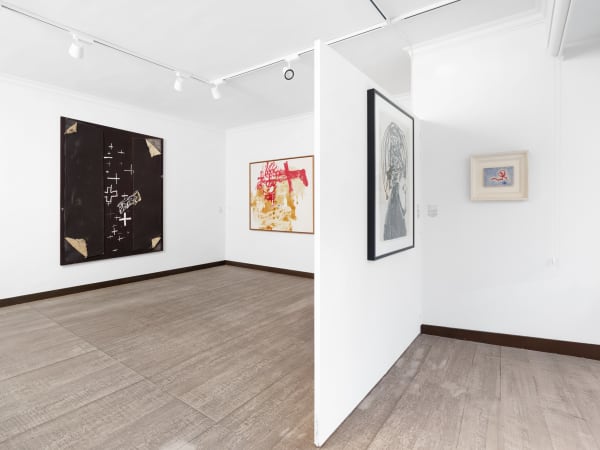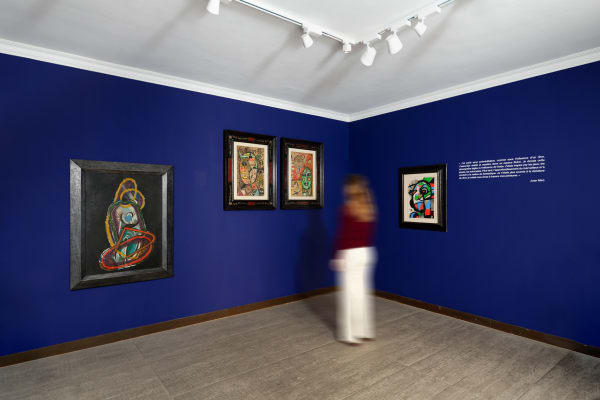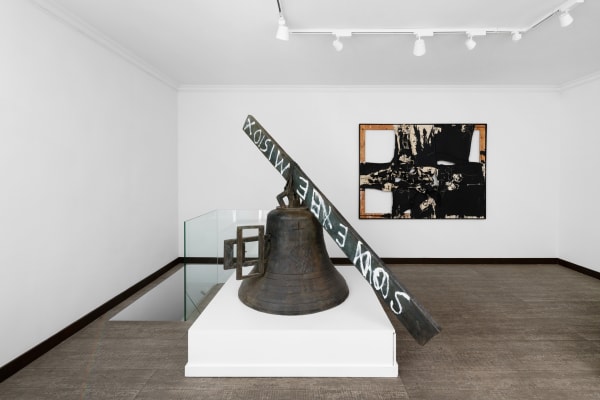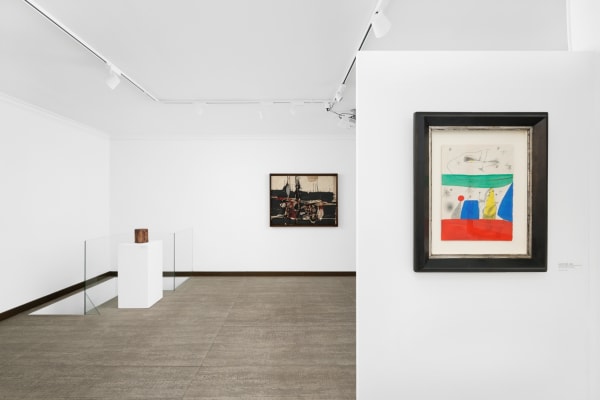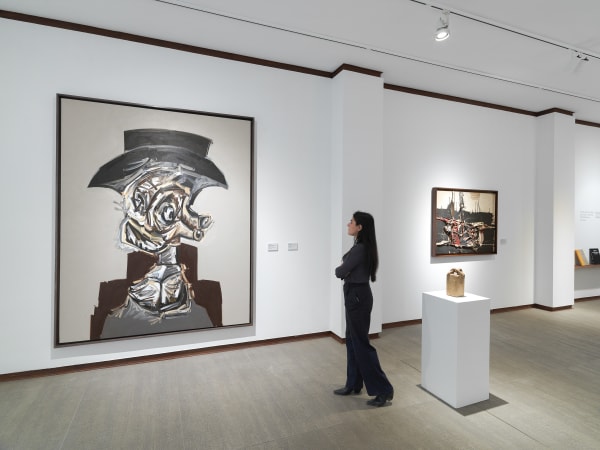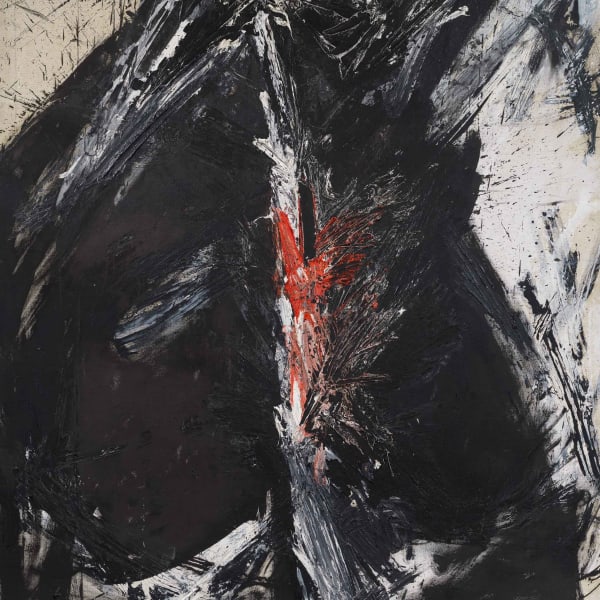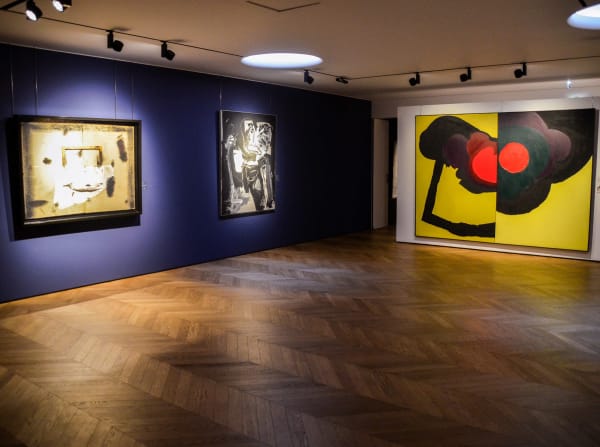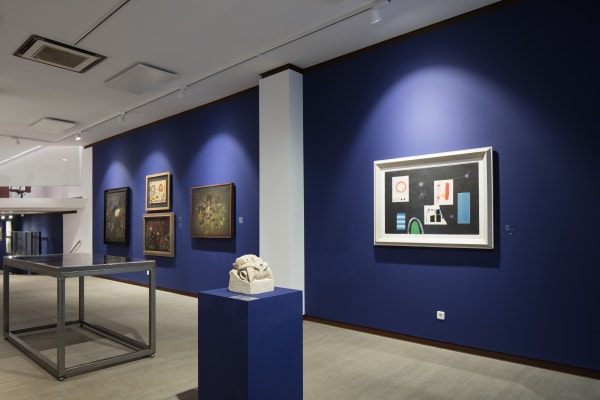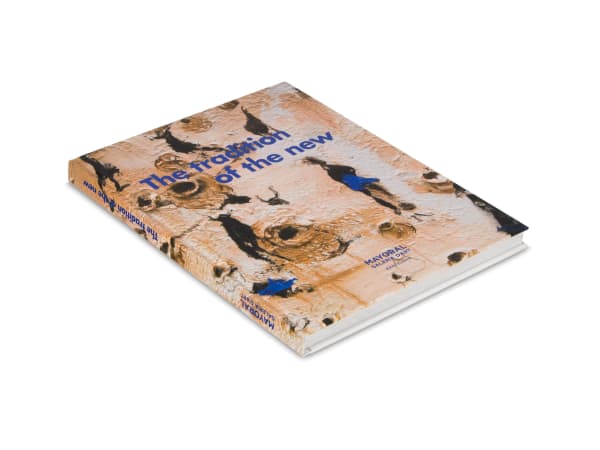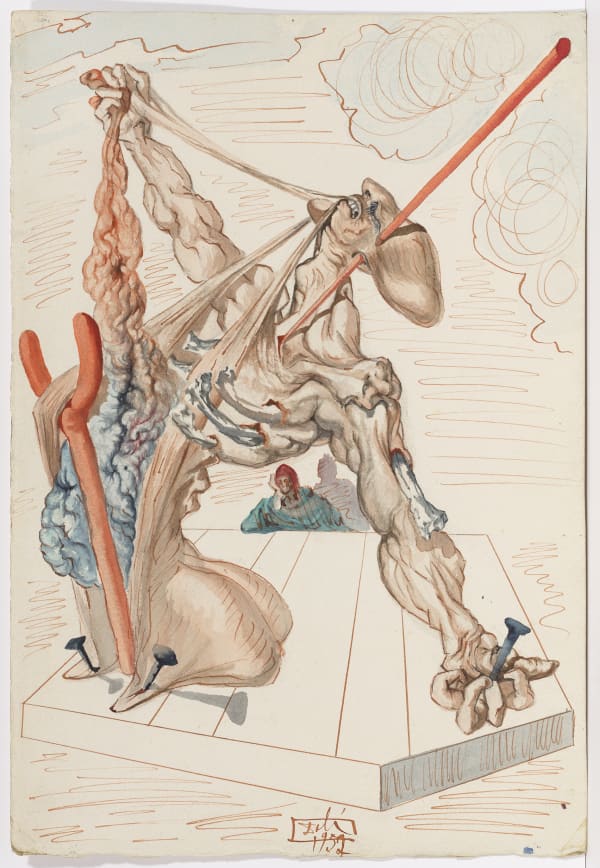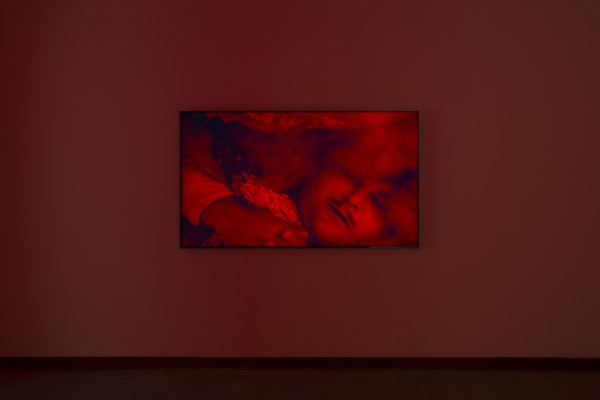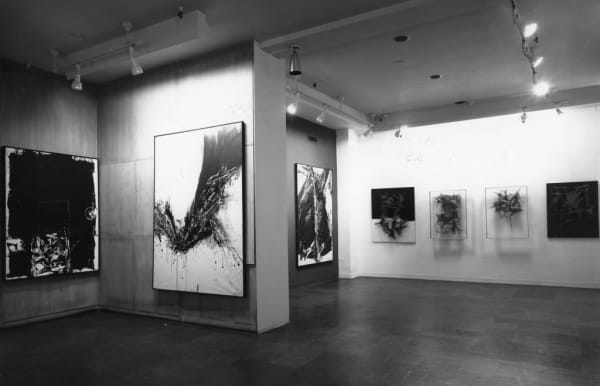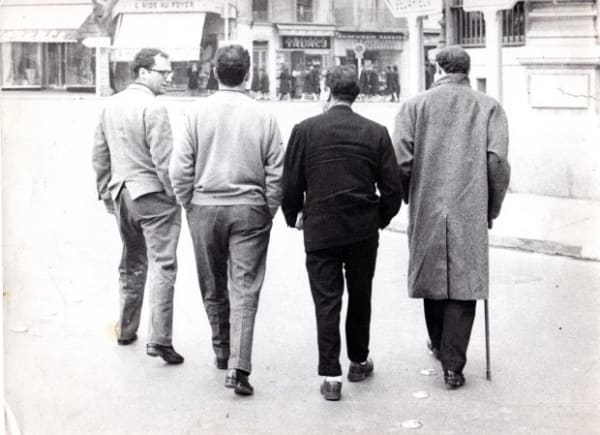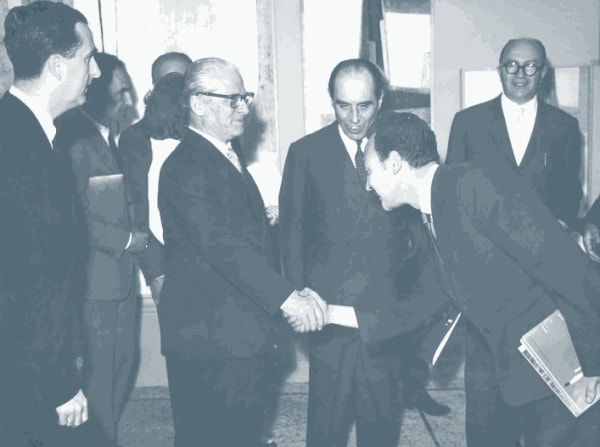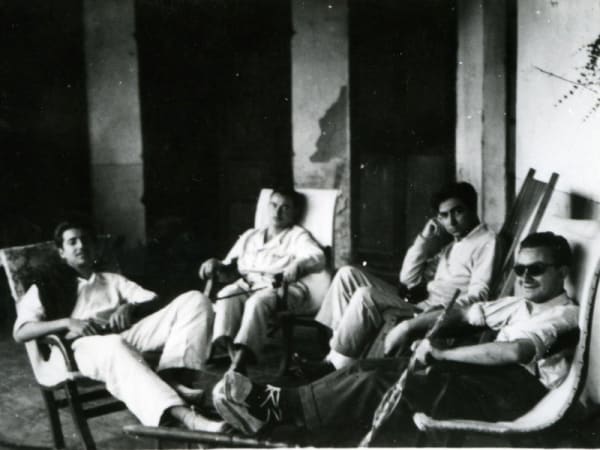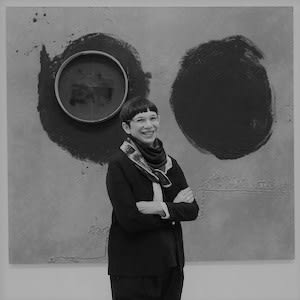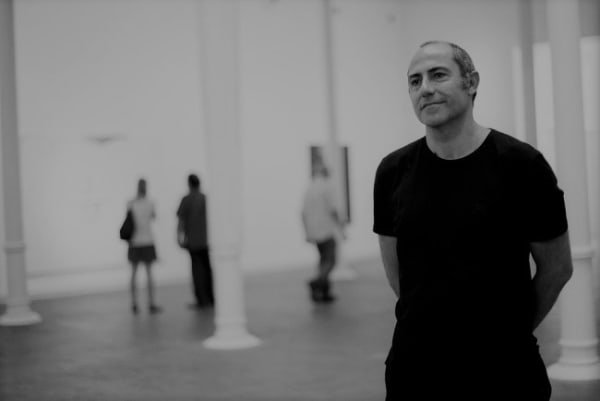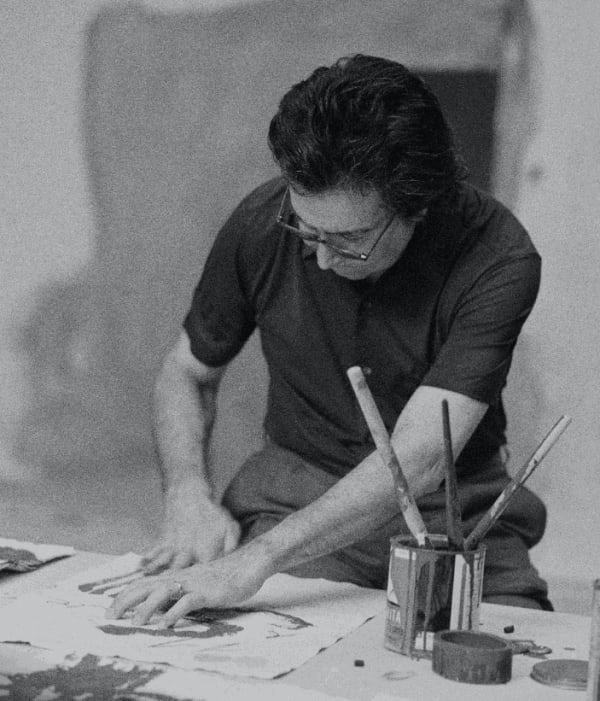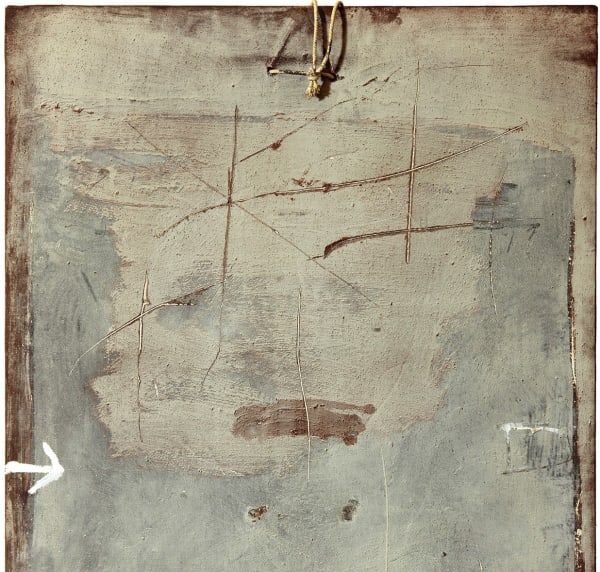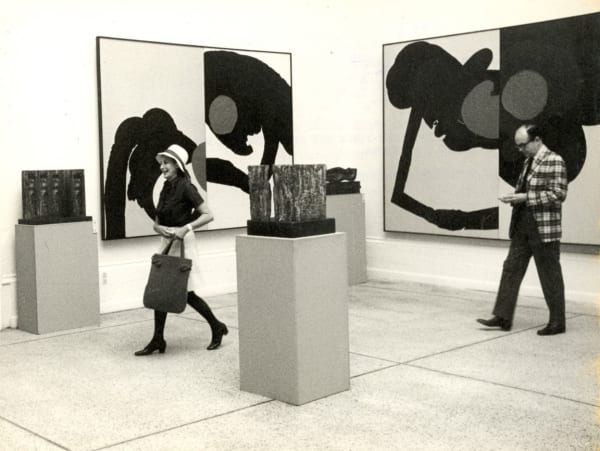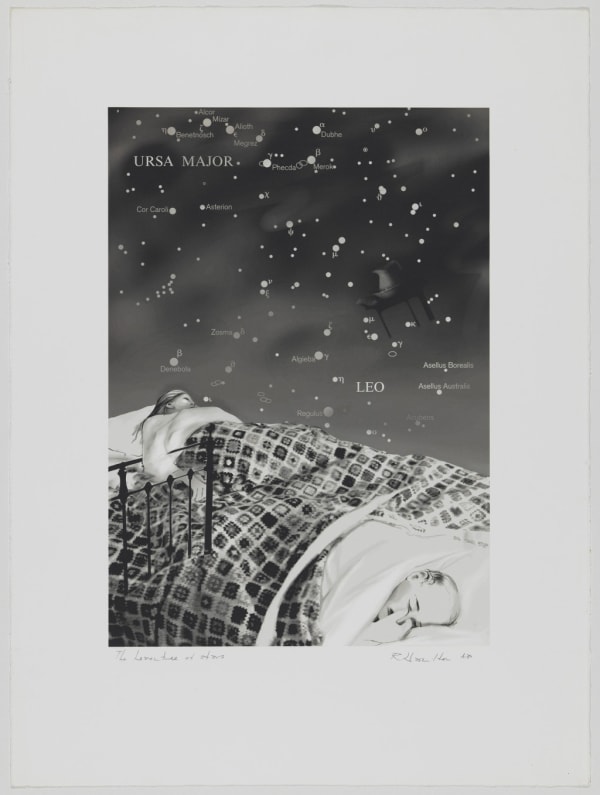Antoni Tàpies Barcelona, 1923-2012
“How many suggestions can be derived from the image of the wall and all its possible permutations! Separation, cloistering, the wailing wall, prison, witness to the passing of time; smooth surfaces, serene and white; tortured surfaces, old and decrepit; signs of human imprints, objects, natural elements; a sense of struggle, of effort; of destruction, cataclysm; or of construction, re-emergence, equilibrium; traces of love, pain, disgust, disorder […]”- Antoni Tàpies
Antoni Tàpies (Barcelona, 1923–2012) began experimenting with art during his adolescence. His growing commitment to drawing and painting led him to abandon his law studies. In the forties, he began exhibiting his works, marked by a strong personality, and together with Joan Ponç, Joan Brossa and others, founded the avant-garde magazine Dau al Set (1948). While Tàpies’ painting showed the influence of Miró and Klee, he was soon adding the iconography, magic themes, geometry and colour studies that would result in his matter paintings. Following the Second World War and the advent of the atomic bomb that shocked artists on both sides of the Atlantic, Tàpies began to express a special interest in matter, earth, dust, atoms and particles. This trend is reflected in the use of materials that are alien to academic artistic expression, such as shoes or socks, and in the experimentation with new techniques. With strongly textured canvases and great expressive possibilities, in the mid-fifties Tàpies reached international recognition as one of the great innovators of Informalism. The matter paintings form a substantial part of the work of Tàpies, to whom matter was also magic, mimesis and alchemy.
Aside from his artistic activities, which he could not conceive apart from the reality of life, Tàpies always maintained a strong moral commitment regarding political and social events. In the late sixties and early seventies, his involvement against the Franco regime intensified, and his works took on the marked character of denunciation. Also at this time, coinciding with the emergence of Arte Povera in Europe and post-Minimalism in the USA, Tàpies punctuated his work with objects, incorporating them into his language. In the following years until the end of his life, oriental culture became decisive in the artist’s production, with a renewed emphasis on matter, on the man-nature identity, and the denial of all dualism. His late works were marked by physical and spiritual reflection.
Tàpies was an intellectual with a great literary and musical knowledge. He worked intensely in the field of graphic art, especially on collector’s books and folios made in collaboration with poets and writers like Alberti, Bonnefoy, Du Bouchet, Brodsky, Brossa, Daive, Dupin, Foix, Frémon, Gimferrer, Guillén , Jabès, Mestres Quadreny, Mitscherlich, Paz, Saramago, Takiguchi, Ullán, Valente and Zambrano, among others. Alongside his artistic activity, Tàpies developed a prolific career as a writer. Among his publications are: A A Personal Memoir (2010), and Collected Essays (2011), which includes essays published in Catalan in six separate books between 1970 and 1999 (The Practice of Art, Art against Aesthetic, Reality as Art, For a Modern and Progressive Art, The Value of Art, Art and Its Places) together with previously uncollected articles, lectures, and other texts. In 1984, with the aim of promoting the study and dissemination of contemporary art, Tàpies founded the Fundació Antoni Tàpies, located in the old publishing house Montaner i Simon, in the heart of Barcelona’s Eixample.
Tàpies’s work has been exhibited in prominent international institutions and has received numerous awards and public recognition. His exhibitions include: Solomon R. Guggenheim Museum, New York (1962); Kunsthaus, Zurich (1962); Institute of Contemporary Arts, London (1965); Musée d’Art moderne de la Ville de Paris (1973); Neue Nationalgalerie, Berlin (1974); Museo Nacional Centro de Arte Reina Sofía, Madrid (1990); Instituto Valenciano de Arte Moderno, Valencia (1992); Museum of Modern Art, New York (1992); Jeu de Paume, Paris (1994); and Museu d’Art Contemporani de Barcelona (2004).
-

Résistance et renaissance : l'art espagnol d'après-guerre
Paris 20 Oct - 20 Dec 2025At a time when history seems suspended and collective memory kidnapped by official silence, post-war Spanish art is offered not as a witness, but as a practice of material resistance...Read more -

RADICALLY UNIQUE, RADICALLY DIFFERENT
Barcelona 21 Nov 2024 - 15 Feb 2025If we champion difference rather than homogeneity, the 20th century appears to be a sequence of irreconcilable personalities. So unique that nothing links them. We could say that the systematic...Read more -

RÊVE. SURRÉALISME ET RÉVOLTE DE L'ESPRIT
PARIS 25 Apr - 5 Jul 2024Humanity’s deep-rooted fascination for dreams experienced a turning point at the beginning of the 20th century after the publication of The Interpretation of Dreams, by Sigmund Freud (1900), a fundamental...Read more -

(IN)COMMUNICATION
PARIS 2 Mar - 20 Apr 2024MILLARES - MUÑOZ - TÀPIESRead more
This exhibition showcases three exemplary artworks by Manolo Millares (1926–1972), Juan Muñoz (1953–2001), and Antoni Tàpies (1923–2012). These pieces serve as poignant illustrations of the imperative to confront and transcend societal taboos by pioneering innovative modes of artistic expression during the Franco regime in Spain. They underscore the vital role of art in elucidating and articulating the ineffable, thereby challenging prevailing norms and fostering dialogue around previously unspoken subjects.
-

EXPLOSION
BARCELONA 11 Jan - 26 Mar 2024Mayoral brings together works by Joan Miró, Antonio Saura, Equipo Crónica, Eulàlia Grau, Antoni Tàpies, Manolo Millares, and Juana Francés presented through the gaze of two explosive scenes from Michelangelo...Read more -

Tàpies i Miró. We come from a silence
PARIS - BARCELONA 10 Oct 2023 - 5 Jan 2024This exhibition, which we are presenting simultaneously in the Paris and Barcelona galleries, brings together in an unprecedented manner two global and modern artists, intensely linked to our culture and fundamental in the gallery’s history: Antoni Tàpies (1923-2012) and Joan Miró (1893-1983). The works exhibited cover the period from 1963 to 1981.Read more -

La radicalité à l'oeuvre
PARIS 6 Jun - 21 Aug 2023Mayoral is delighted to announce its summer group exhibition, showcasing a selection of works by post-war artists who, in their individual ways, embraced a radical approach in their creative processes:...Read more -

Saura in his context
BARCELONA 13 Apr - 30 Jun 2023This exhibition, organized in conjunction with Enrique Juncosa, presents six very characteristic works by Antonio Saura (1930-1998), one of the most important Spanish artists of the 20th century, in dialogue...Read more
-

Abstract Nature
BARCELONA 2 Oct - 20 Nov 2021Mayoral presents an exhibition which highlights the role of the landscape in the work of Fernando Zóbel linked to three great Catalan postwar abstract artists who were also particularly sensitive...Read more -

An Hommage to Pierre Matisse
PARIS 15 Sep - 11 Dec 2021Mayoral presents an exhibition in celebration of Pierre Matisse, one of the most important modern art dealers in the world, illustrating how he enabled certain Spanish post-war avant-garde artists to...Read more -

Zóbel and the Great Post-War Generation
MADRID 12 - 21 Mar 2021Mayoral’s first exhibition in Madrid, ‘Zóbel and The Great Post-War Generation’, will be held from the 11th to 21st March at the Fundación PONS. The exhibition brings together more than...Read more -

Tàpies Today
PARIS 6 Feb - 8 Jul 2020Mayoral is delighted to present “Tàpies Today,” the second exhibition at our Parisian gallery. The exhibition features a selection of eight paintings by Antoni Tàpies – carefully chosen by the...Read more
-

Venezia 1958
BARCELONA 26 Sep - 4 Dec 2019The Galeria Mayoral revisits an exhibition held in the Spanish Pavilion at the 1958 Venice Biennale. This is the first time an exhibition reunites, more than 60 years after the...Read more -

Tàpies Today
BARCELONA 17 Jan - 13 Apr 2019Mayoral is pleased to present 'Tàpies Today', a monographic exhibition devoted to Antoni Tàpies which follows the artist’s creative trajectory and argues for the validity and relevance of his work...Read more -

With Rebellion Awareness is Born
BARCELONA 26 Sep 2018 - 5 Jan 2019Mayoral is pleased to present the exhibition With Rebellion, Awareness Is Born , a look at Spanish art of the postwar period which includes a painstaking selection of works by...Read more -

Postwar Art in Spain
LONDON 26 Feb - 8 Mar 2018We are pleased and proud to present this exhibition on the art of the Spanish postwar years, featuring exceptional works by Brossa, Feito, Millares, Saura and Tàpies, in London. It...Read more
-

The Space of Dreams
BARCELONA 12 Sep 2017 - 5 Jan 2018Through an accurate selection of works of art, the exhibition shows the importance that the dream has had as a constructor of the artistic language of the 20th century to...Read more -

The Space of Dreams
CADAQUÉS 21 Jul - 15 Aug 2017Through an accurate selection of works of art, the exhibition shows the importance that the dream has had as a constructor of the artistic language of the 20th century to...Read more
-

ART BASEL
JUNE 13 - 16, 2024 2024Paperback, 50 pagesRead more
Publisher: Mayoral Investigació
Dimensions: 29.8 x 21 x 0.5 cm -

Venezia 1958
2019Hardcover, 198 pagesRead more
Publisher: Mayoral Investigació
Dimensions: 31,5 x 23,5 cm -
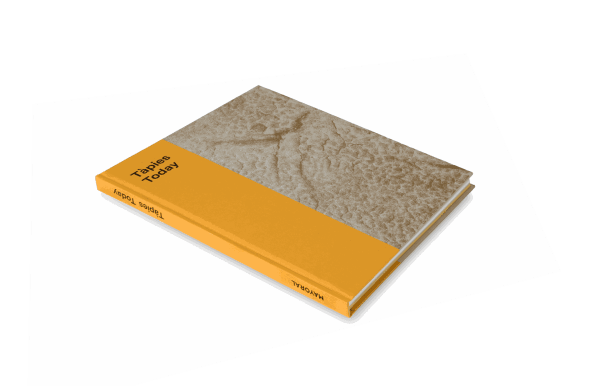
Tàpies Today
2019Hardcover, 181 pagesRead more
Publisher: Mayoral Investigació
Dimensions: 24 x 32 cm -

With rebellion awareness is born
2018Hardcover, 120 pagesRead more
Publisher: Mayoral Investigació
Dimensions: 23,5 x 17 cm
-

Postwar art in Spain
2018Softcover, 21 pagesRead more
Publisher: Mayoral Investigació
Dimensions: 21 x 14.9 cm -

The Space of Dreams
2017Hardcover, 182 pagesRead more
Publisher: Mayoral Investigació
Dimensions: 16 x 22 cm -
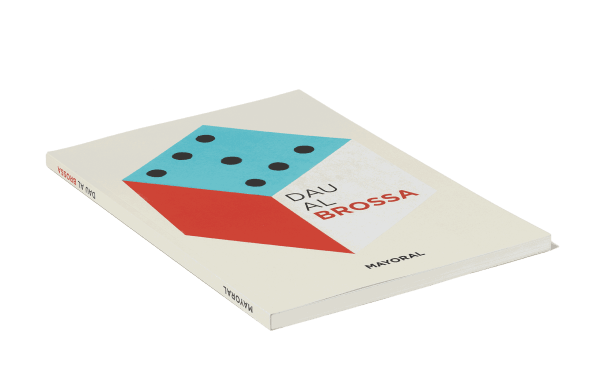
Dau al Brossa
2016Softcover, 139 pagesRead more
Publisher: Mayoral Investigació
Dimensions: 30 x 21 cm -
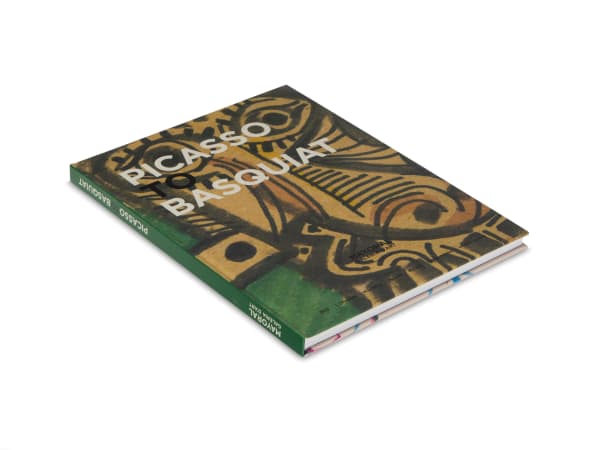
Picasso to Basquiat
2013Hardcover, 135 pagesRead more
Publisher: Mayoral Investigació
Dimensions: 31.7 x 24 cm
-

La Monnaie vivante
What can a body do? If everything is reduced to mere merchandise, how can we be a body that does not put exchange value before use value?. Text by Pedro G. Romero September 15, 2025La monnaie vivante is the title of an essay and a series of performative and photographic works promoted by Pierre Klossowski in 1970. Michel Foucault...Read more -

Radically unique, radically different
Carles Guerra presents a great show that mixes the 20th and 21st centuries, with the occasion of the 35th anniversary of the Galeria Mayoral November 18, 2024Catalan version Spanish version Galeria Mayoral is celebrating 35 years devoted to modern and contemporary art. The brilliant artists from the most iconic avant-garde share...Read more -

Tàpies and Miró, a radical collaboration
CARLES GUERRA DISCUSSES THE CONVERGENCE BETWEEN THE WORKS OF TÀPIES AND MIRÓ. October 11, 2023Antoni Tàpies (1923-2012) and Joan Miró (1893-1983) form an exceptionally genuine tandem, characteristic of 20th-century modernity. Global artists, to a greater or lesser extent, but...Read more -

Un hommage à Pierre Matisse : une conversation entre Claudine Grammont et Elise Lammer modérée par Siân Folley
Claudine Grammont, Elise Lammer and Siân Folley talks about the exhibition "Un hommage à Pierre Matisse" at Galeria Mayoral, Paris November 19, 2021An Hommage to Pierre Matisse, Galeria Mayoral, Mayoral, Barcelona, Paris, Tàpies, Miró, millares, Canogar, Rivera, Saura, ExhibitiomRead more -

Pierre Matisse and the Spanish avant-garde | Elise Lammer
Elise Lammer, curator of "Pierre Matisse and the Spanish avant-garde" talks about the exhibition at Galleria Mayoral, Paris-Barcelona September 11, 2021It is not rare today to witness the same artist evolving across multiple galleries over the course of their career. Typically an artist would enter...Read more -

Conversación entre Alfonso de la Torre y Elvira Maluquer con la participación de Jordi Mayoral (SPANISH)
Jordi Mayoral talks with Alfonso de la Torre and Elvira Maluquer on the exhibition "Abstract Nature" at Galeria Mayoral, Barcelona September 2, 2021Con motivo de la inauguración de la exposición «Naturaleza abstracta»: Jordi Mayoral (JM): Per a nosaltres és una alegria inaugurar l’exposició «Naturalesa abstracta» amb dues...Read more -

A Conversation between Wilfredo Prieto and Rosa Lleó
On the occasion of the exhibition "Venezia 1958" at Galeria Mayoral, Barcelona October 31, 2019Mangos, Limes and Flags In 1958, Spain, like Portugal, was an insular, extremely poor country with a strong presence of the military and of Opus...Read more -

A Conversation between Pere Portabella and Vicenç Altaió
On the occasion of the exhibition "Venezia 1958" at Galeria Mayoral, Barcelona October 30, 2019We found ourselves in the dark night of the Franco dictatorship dominated by Castilianity and the cross: National Catholicism. A new generation, which hadn’t fought...Read more -

Bearing Witness to the 1958 Venice Biennale | Luis González Robles
Luis González Robles, curator of the Spanish Pavilion, speaks about the 29th Venice Biennale October 11, 2019Spanish Artists in the 29th Venice Biennale International Art Exhibition Spanish Pavilion, 1958 For this 29th Venice Biennale a series of works by artists representative...Read more -

On the 1958 Venice Biennale, Still | María Dolores Jiménez-Blanco
María Dolores Jiménez-Blanco talks about the 1958 Venice Biennale October 5, 2019The Spanish Pavilion at the 29th Venice Biennale, the edition held in 1958, has become an inevitable landmark in narratives to do with Spanish art...Read more -

Tàpies Today | Arnau Puig
Arnau Puig, philosopher and founder of Dau al Set speaks about the remaining importance of Tàpies work April 4, 2019Mayoral is pleased to present 'Tàpies Today', a monographic exhibition devoted to Antoni Tàpies which follows the artist’s creative trajectory and argues for the validity...Read more -

Ochre with Six Collages | Elise Lammer
Elise Lammer talks about the work "Ochre with Six Collages", published in the exhibition catalogue "Tàpies, today" March 7, 2019More than a painted canvas Ochre with Six Collages is a hanging sculpture. Like other works from the same period it is seemingly made of...Read more -

A Specific Void | Laura Copelin
An analysis of works in the exhibition "Tàpies, today" published in the catalogue of the exhibition March 4, 2019In Antoni Tàpies’s Empremtes de plats (Plate Prints ) a thick cloth appears to be cast horizontally over the center of the painting’s field. A...Read more -

Interviews with the Fundació Antoni Tàpies’ former and current directors. Manuel Borja-Villel | Llucià Homs
Interviews with the ‘Fundació Antoni Tàpies’ former and current directors by Llucià Homs. Published in the exhibition catalogue "Tàpies, today" January 31, 2019An Interview with Manuel Borja-Villel Director of the Fundació Antoni Tàpies 1990-98 Madrid, MNCARS, 13 September 2018 Llucià Homs: After these twenty-five years of the...Read more -

Interviews with the Fundació Antoni Tàpies’ former and current directors. Nuria Enguita | Llucià Homs
Interviews with the ‘Fundació Antoni Tàpies’ former and current directors by Llucià Homs. Published in the exhibition catalogue "Tàpies, today" January 31, 2019An Interview with Nuria Enguita Director of the Fundació Tàpies 1998-2008 Valencia, by telephone, 18 July 2018 Llucià Homs: Nuria, what was your personal experience...Read more -

Interviews with the Fundació Antoni Tàpies’ former and current directors. Laurence Rassel | Llucià Homs
Interviews with the ‘Fundació Antoni Tàpies’ former and current directors by Llucià Homs. Published in the exhibition catalogue "Tàpies, today" January 31, 2019An Interview with Laurence Rassel Director of the Fundació Antoni Tàpies 2008-15 Brussels, by telephone, 24 July 2018 Llucià Homs: What was your personal experience...Read more -

Interviews with the Fundació Antoni Tàpies’ former and current directors. Carles Guerra | Llucià Homs
Interviews with the ‘Fundació Antoni Tàpies’ former and current directors by Llucià Homs. Published in the exhibition catalogue "Tàpies, today" January 31, 2019An Interview with Carles Guerra Director of the Fundació Antoni Tàpies since 2015 Barcelona, 25 July 2018 Llucià Homs: Carles, what has your personal experience...Read more -

Historical testimonies on Antoni Tàpies | Michel Tapié
A collection of testimonies about Tàpies given by Michel Tapié, Yvon Taillandier, Dan Evans and Roland Penrose. Published in the exhibition catalogue "Tàpies, Today" January 21, 2019The work of Antonio Tàpies is provocative, like all creative art; as communication it is unfathomable, secretive. It is not an enigma to be unravelled,...Read more -

Antoni Tàpies: Updated Reflections | Arnau Puig
Arnau Puig, friend of the artist and an expert in his work since the creation of the group Dau al Set, makes some reflections about Tàpies in his last curated exhibition "Tàpies, Today", at Galeria Mayoral-Paris January 9, 2019Tàpies was a conceptual artist par excellence because he always needed the support of the material, a reality that he, through his perception, which was...Read more -

With rebellion, awareness is born | Video
Video tour of the exhibition "With rebellion, awareness is born" at Galeria Mayoral, Barcelona November 21, 2018Mayoral is pleased to present the exhibition 'With rebellion', awareness is born, a look at Spanish art of the postwar period which includes a painstaking...Read more -

Changer La Vie
A text by Albert Serra July 21, 2017The night is the door to true life, that full life in which the impossible rules and death does not impose its law. It is...Read more -

Artistic Dreams
Llucià Homs in conversation with Hans Ulrich Obrist regarding Sogni/Dreams project Basel July 21, 2017After a few attempts to meet with Hans Ulrich Obrist in London, we finally do so during Art Basel, in one of the terraces of...Read more -

Joan Miró: Dreaming While Awake
Rosa Maria Malet talks about "Surrealism and the Dream" July 21, 2017[Excerpts from the paper given at the Surrealism and the Dream international congress held at the Museo Thyssen-Bornemisza on 8 and 9 October 2013] “I...Read more




